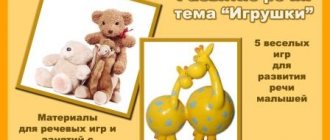Progress of the game.
The teacher invites the children onto the carpet and picks up the ball:
“Let's play ball and form the words of one family for the word road . What can you call a small road? (Track)
.
How can you affectionately name the road? (Dorozhenka)
.
What is the name of the plant that grows next to the road? (Plantain)
.
What is the movement on the road called? What is it like? (Road)
.
Fine! You have selected many words from one family . Now, let's put together another family of words for the word car . What can you call a small car? (Car driver)
.
What about a very large car? (Car)
.
What do you call a person who drives a train? (Machinist)
.
What is the name of car engine oil? (Car oil)
.
Well done, everything is correct. All the words you just spoke are derived from the word “car”
.
Game exercise “Choose an action”
Goal: to activate the verb dictionary on the topic “Road Rules”
Material (as needed)
: story pictures on the topic
Game actions. Match the noun with as many verbs as possible.
Progress of the game.
The game is played several times.
For the first time, the adult reads out the text of the route, making a short pause after each verb, and the child shows the route in the picture. Teacher: “Drive your index finger along the road the way a car should drive. Be an attentive driver - drive the car exactly along its route. Let's begin our journey. The car drove and drove and reached the mountain; I drove up the mountain, drove down the mountain, and continued on. I drove around the pit and reached the river; I drove across the bridge, crossed the rails and came home.”
The next time the adult is silent, and the child “drives” the car and comments on its movement: “Now tell me what the car’s route was.” Then you can invite the child to travel in the opposite direction.
Annex 1.
Game exercise “Say the opposite”
Target. Mastering verbs with different prefixes. Development of dexterity and coordination of movements.
Game actions. Selection of antonyms.
Material. Ball.
Progress of the game.
The teacher invites the children to listen and complete the sentences :
- Wheel made of rubber. It (what)
.
(rubber)
.
— The car door is made of metal. She (what)
.
(metal)
.
— The steering wheel of the bus is made of plastic. He (what)
.
(plastic)
.
— Seat covered in leather. It (what)
.
(leather)
.
— Rubber rod. He (what)
.
(rubber)
.
— Stop made of iron. She (what)
…
(iron)
.
— Plastic whistle. He (what)
…
(plastic)
.
— Glass headlights. They (what)
…
(glass)
.
Game exercise “Yes - no”
Goal: to consolidate the ability to coordinate numerals with nouns.
Material: subject pictures on the topic “Road Rules” (two batons, five traffic lights, five road signs, three caps, etc.)
Game actions. Count the objects in the picture and name them.
Progress of the game.
Teacher: Travelers or tourists use different types of transport. Since there are many tourists, there are also many vehicles. Now I will name one vehicle, and you must name what vehicles tourists travel on.
For example: I will say - the tourist will ride a bicycle, and you must say - and the tourists will ride bicycles.
Note: Children must highlight the endings in answer words .
Car, train, plane, steamship, motorcycle, bus, airbus, lunar rover, all-terrain vehicle, jeep, sleigh, rocket, motor ship, train, car, etc.
Game exercise “Happy Journey”
Goal: to intensify the use of prefixed verbs.
Material: story picture (see Appendix 1)
.
Game actions. Make up a story based on the plot picture.
Progress of the game.
The teacher calls the first part of the sentence , and the child finishes it.
— There was an accident at the intersection because...
— The car was slipping and could not move because...
— A lot of people gathered at the stop because...
— The driver braked at the pedestrian crossing because...
— At the traffic light, all the cars slowed down because...
— The traffic inspector stopped the car because...
“The children couldn’t cross the road for a long time because...
— The driver honked at the boy because...
Game " Word Family "
Goal: to consolidate the ability to form words .
Material: ball.
Game actions. Form words with the same root first for the word road , and then for the word car .
Progress of the game.
Ball game. Children stand in a circle, the teacher is in the center. The teacher throws the ball to the child and pronounces the verb, the child must name the antonym word and return the ball .
I drove up - I drove off, I drove in - I drove out,
drove in - left,
drove off - rolled up, left - arrived,
approached - moved away, came - left, entered - left, etc.
Game exercise “Name the picture”
Goal: to consolidate the ability to understand prefixed verbs; intensify their use in speech.
Material: story pictures (see appendix 2)
.
Game actions. Name what you see in the picture in a complete sentence .
Progress of the game.
The teacher shows the children pictures and says: “Guys, look at the pictures carefully. In the first of them the car drives up to the garage, in the second it leaves the garage, in the third it goes around the garage, in the fourth it drives between two garages, in the fifth it drives over a bridge, in the sixth it drives off the bridge. Now answer the questions:
— In which picture do we see a car that
leaving? (In the second picture the car is leaving the garage)
.
— In what picture do we see a car approaching? (Children's answers)
.
— In what picture do we see a car passing?
— In what picture do we see a car moving?
— In what picture do we see a car driving around?
— In what picture do we see a car moving away?
- Now remember and name the action words that are formed from the word go . (Children's answers)
«.
Appendix 2
Game "Fun Racing"
Goal: to intensify the use of verbs with prefixes, simple prepositions .
Material: playing field and model cars.
Game actions. Comment on your actions.
Progress of the game.
The teacher invites the children to sit on the carpet and places a playing field in front of them - a large circle on which a track is depicted; he gives the children one model of passenger car of different colors. After which the teacher says: “And now you will move your cars along the playing field and tell what are they doing. Try not to repeat yourself. Let your cars perform completely different actions, move along different routes.”
Children perform actions and comment on them: “My red car left the garage and drove down the road. My blue car drove down the road and arrived at the store. My green car drove up to the bridge, drove onto the bridge, drove across the bridge, drove off the bridge. My yellow car drove around the house, across the road and into the garage.”
The teacher says after all the children’s answers: “What similar words were heard in your answers? (Check out, went, drove in, moved out, drove around, drove in, moved)
.
All these words are derived from the word “to go .”
Note. If children find it difficult, the teacher can ask leading questions.
Game exercise “Pick up a small word “
Goal: to intensify the use of simple prepositions .
Game actions. Choose the right preposition .
Progress of the game.
Teacher: “Guys, now we’ll play with words . I will name the word action words for it as possible ; answer the question “what does it do?” What does the car do? (Drives, honks, brakes, rushes, stops)
. What is the driver doing? What does a traffic light do? What does the traffic controller do? What is the pedestrian doing?
Children select action words and receive a chip for each correct answer. At the end of the game , children count their chips and name the winner.
Game exercise “Tourists”
Target. Development of the lexical and grammatical structure of speech. Mastering the instrumental case of plural nouns.
Progress of the game.
Teacher: “I suggest playing the game “Yes or no.” The first player will name what he has in the picture. For example: “I have two wands.” The next player will continue : “I don’t have two wands, but I have five traffic lights.” And so on in a circle."
Outdoor game "Cars"
Goal: improve the ability to coordinate speech with movements; develop creative imagination.
Game actions. Repeat the movements and text of the poem after the teacher.






